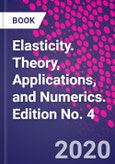Elasticity: Theory, Applications, and Numerics,�Fourth Edition, continues its market-leading tradition of concisely presenting and developing the linear theory of elasticity, moving from solution methodologies, formulations, and strategies into applications of contemporary interest, such as fracture mechanics, anisotropic and composite materials, micromechanics, nonhomogeneous graded materials, and computational methods.
Developed for a one- or two-semester graduate elasticity course, this new edition has been revised with new worked examples and exercises, and new or expanded coverage of areas such as treatment of large deformations, fracture mechanics, strain gradient and surface elasticity theory, and tensor analysis. Using MATLAB software, numerical activities in the text are integrated with analytical problem solutions. Online ancillary support materials for instructors include a solutions manual, image bank, and a set of PowerPoint lecture slides.
Please Note: This is an On Demand product, delivery may take up to 11 working days after payment has been received.
Table of Contents
Part 1: Foundations and elementary applications1. Mathematical Preliminaries2. Deformation: Displacements and Strains3. Stress and Equilibrium4. Material Behavior Linear Elastic Solids5. Formulation and Solution Strategies6. Strain Energy and Related Principles7. Two-Dimensional Formulation8. Two-Dimensional Problem Solution9. Extension, Torsion, and Flexure of Elastic Cylinders
Part 2: Advanced applications10. Complex Variable Methods11. Anisotropic Elasticity12. Thermoelasticity13. Displacement Potentials and Stress Functions: Applications to Three-Dimensional Problems14. Nonhomogeneous Elasticity15. Micromechanics Applications16. Numerical Finite and Boundary Element Methods








